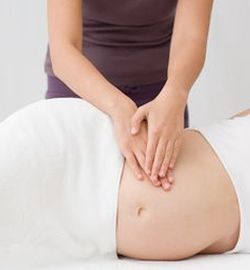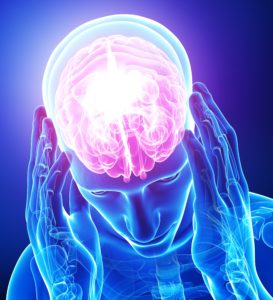 Chronic headaches and migraines can be caused by many different things, including hormonal changes and chemical imbalances. Sometimes the cause is simply unknown. However, in many cases, acute and chronic headaches stem from tension and spasm in the cervical muscles and compression of nerves.
Chronic headaches and migraines can be caused by many different things, including hormonal changes and chemical imbalances. Sometimes the cause is simply unknown. However, in many cases, acute and chronic headaches stem from tension and spasm in the cervical muscles and compression of nerves.
Anyone who suffers from chronic headaches should be assessed by a qualified Medical Massage therapist to rule out or confirm the involvement of soft tissue in their condition. This is especially true for those who have migraines, but do not experience any type of aura prior to the attack.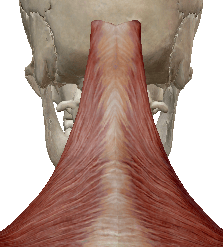
There are several muscles that can cause severe headaches. The first of which is the trapezius muscle. This large muscle that covers the upper back and neck is a common source of neck pain and headaches.
Because of daily activity, the trapezius muscle is subject to chronic overload, which can result in tension and shortening of the muscle. When it houses active trigger points (nasty little knots that refer pain), it can produce neck pain as well as headaches.
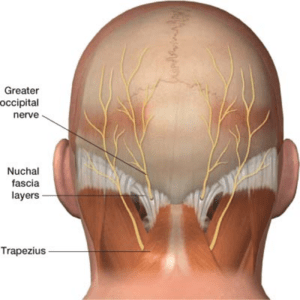 In some cases, tension in the upper trapezius can compress the greater occipital nerve, resulting in Greater Occipital Nerve Neuralgia. Symptoms are a dull, drilling pain in the morning in the occipital area, neck and shoulders. The neck is stiff and uncomfortable. Pain is normally felt on one side of the head. There is no aura, distinguishing this headache from a migraine. Pain can be local or radiate to the forehead.
In some cases, tension in the upper trapezius can compress the greater occipital nerve, resulting in Greater Occipital Nerve Neuralgia. Symptoms are a dull, drilling pain in the morning in the occipital area, neck and shoulders. The neck is stiff and uncomfortable. Pain is normally felt on one side of the head. There is no aura, distinguishing this headache from a migraine. Pain can be local or radiate to the forehead.
In other cases, the temporal artery is constricted due to the tension the upper trapezius muscle. When this occurs, it results in an acute vascular headache or migraine. This headache is much more severe than one from just an active trigger point and affects half the head and eye.
Another muscle for careful consideration with chronic headaches is the semispinalis capitis muscle. 
A major contributor to headaches, this muscle is sometimes missed by therapists and medical practitioners. Due to its anatomical location, it has a tendency to simply irritate, instead of compress, the greater occipital nerve. Because of this, patients will complain of a headache, but not associate it with the occipital area.
These headaches can be misdiagnosed as migraines. The headaches are constant, moderate type headaches that may flare up as migraines, but without an aura. During flare-ups, patients may experience autonomic reactions, such as dizziness, nausea or sweating.
Other muscular trigger points can also cause headaches.
 The sternocleidomastoid muscle can house active trigger points that are misdiagnosed as a cluster headache. Jaw pain from these trigger points may also be present, as well as dizziness or pain when swallowing.
The sternocleidomastoid muscle can house active trigger points that are misdiagnosed as a cluster headache. Jaw pain from these trigger points may also be present, as well as dizziness or pain when swallowing.
The spenius capitis trigger point causes pain on the top of the head. This pain may worsen when extending the head backwards. 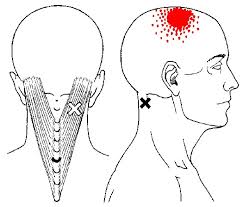
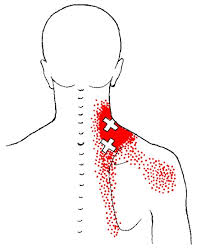 The levator scapulae muscle causes pain around the base of the neck and shoulder, as well as on the inside of the shoulder blade. It can also cause headaches that have a referred character to them. In other words, you will feel pain in the shoulder and neck area first, with a headache that is clearly stemming from the neck.
The levator scapulae muscle causes pain around the base of the neck and shoulder, as well as on the inside of the shoulder blade. It can also cause headaches that have a referred character to them. In other words, you will feel pain in the shoulder and neck area first, with a headache that is clearly stemming from the neck.
If you are dealing with chronic headaches, it is important to have a proper evaluation of these muscles. Simple tests performed by a medical massage practitioner can help identify whether or not your symptoms are a result of tension in your neck. If they are a direct result, massage therapy is the best course of action to eliminate the problem effectively.

